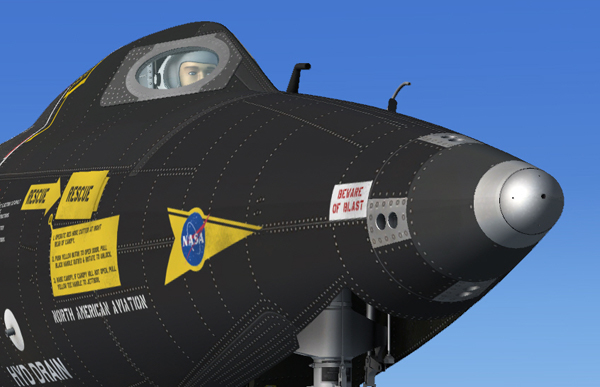
NACA-Nortronics ball nose and pitot heads on the nose section of the fuselage of the X-15A-2 SE.
Pitot pressure for the conventional airspeed indicator [5, fig. 5-1] and altimeter [3, fig. 5-1] is supplied by the fuselage-mounted static "dog-leg" pitot tube [15, fig. 3-1].
A retractable pitot tube [38, fig. 3-1] is installed ahead of the static pitot tube. The retractable pitot tube is provided on the X-15A-2 because the static tube's operating temperature limits would be exceeded at higher Mach numbers. Also, the retractable pitot tube, when retracted, is protected from possible ablator spills. The retractable pitot tube remains within the fuselage until the airplane decelerates to below Mach 2.
Static pressure is supplied by ports on each side of the fuselage, forward of the cockpit area.
The NACA-Nortronics ball nose [17, fig. 3-1] is a sphere-shaped, pitot-pressure, flow-direction sensor. The ball simultaneously measures angle of attack and angle of sideslip through two complete and independent servo systems.
One system controls the vertical and one the horizontal axis. As the airplane encounters a sideslip condition or change in angle of attack, the respective system will turn the ball (electro-hydraulically) into the relative wind. The difference between airplane heading and relative wind is then transmitted through sensors to cockpit instruments to read angle of attack and angle of sideslip.
Electrically, the ball nose is powered through the instrumentation transformer, which in turn is powered by the No. 2 primary AC bus.
Hydraulic power for the ball nose is provided from the No. 1 hydraulic system. If hydraulic system No. 1 fails, the ball nose will not turn in response to sensor signals. In this event, the angle-of-attack and sideslip indicators (on the attitude indicator [9, fig. 5-1]), although inoperative, will provide erroneous indications, as they will continue to register the conditions at the time of the power failure.
In case of electrical failure, the indicators may show a continually unsafe condition.
In this section:
Pitot-Static System Instruments and Controls